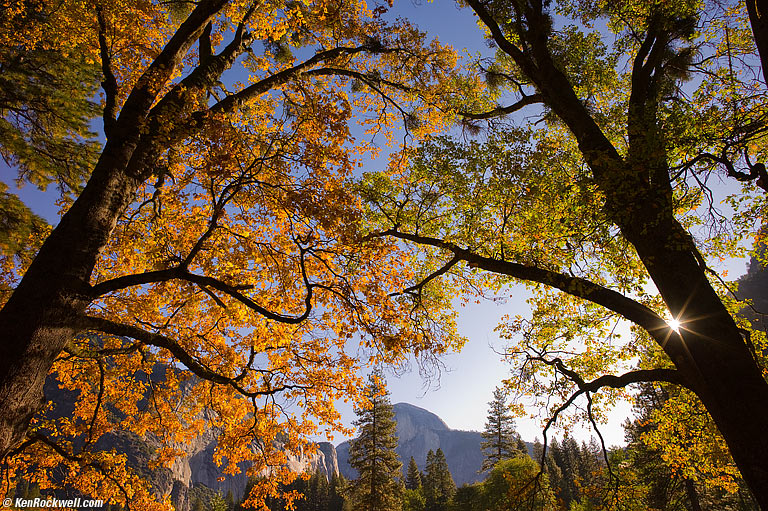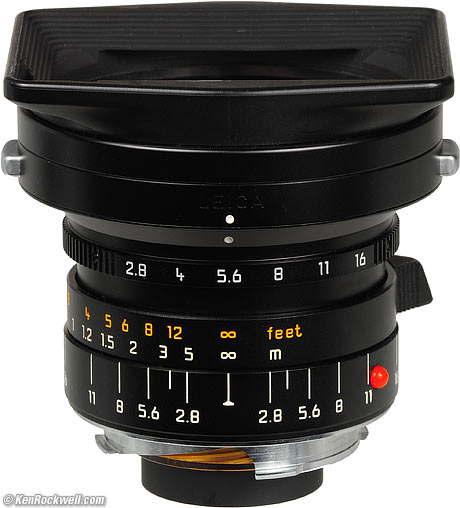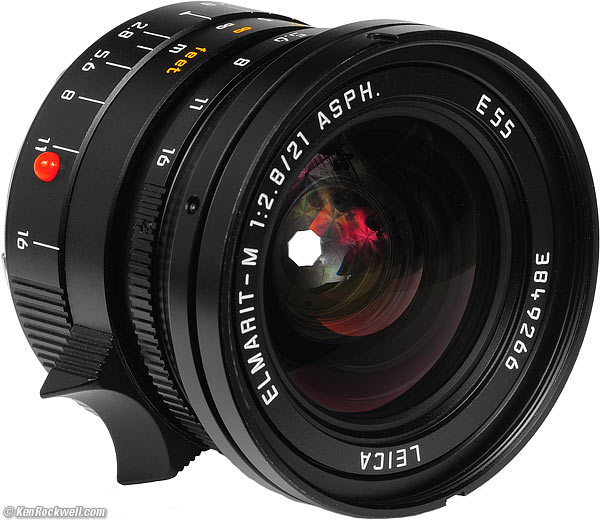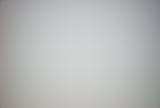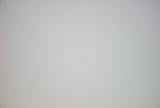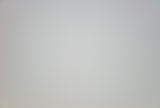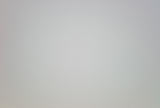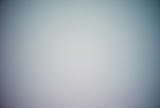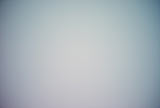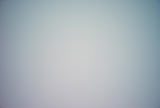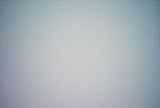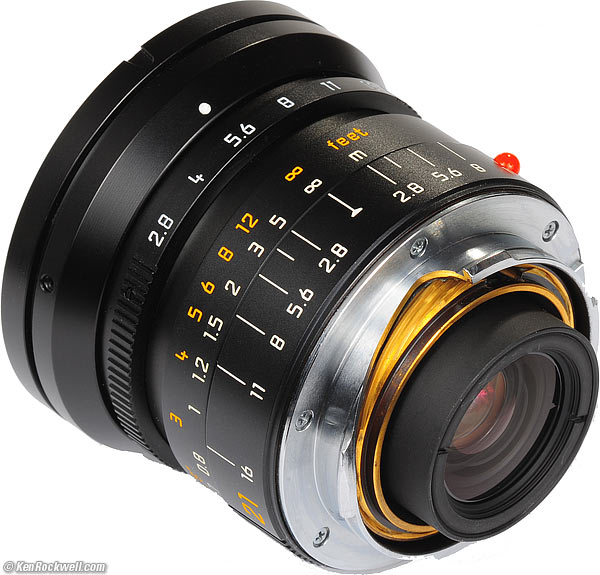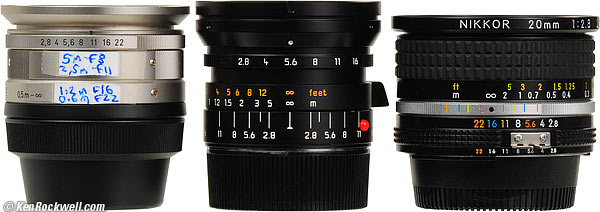Home Donate New Search Gallery Reviews How-To Books Links Workshops About Contact
LEICA 21mm f/2.8 ASPH
ELMARIT-M (1997-2011)
© 2011 KenRockwell.com. All rights reserved.
Intro Specs Performance Compared Recommendations
LEICA 21mm f/2.8 ASPH (aspherical, 55mm filters, 11.2 oz/317g (12.2 oz./347g with hood), about $4,400 new). enlarge. This free website's biggest source of support is when you use these links, especially this link directly to them at eBay, where they sell for about $4,000 (see How to Win at eBay). It helps me keep reviewing these oldies when you get yours through these links, thanks! Ken.
November 2011, February 2009 LEICA Reviews LEICA Lenses all reviews
NEU: LEICA SUPER-ELMAR-M 21mm f/3.4 Review
Yosemite Valley, Yosemite National Park, 9:11 AM, 20 October 2009.
Original DNG (18MB). Full-resolution JPG created in Photoshop CS4 (12MB).
Complement: hand-held LEICA M9, LEICA ELMARIT-M 21mm f/2.8 ASPH, f/8 at 1/180 second, ISO 160.
Sample © JPG Image (12 MB) and sample © raw file (18MB DNG).
May 2012: This lens for sale at OC Camera via eBay.
LEICA 21mm lenses compared Comparison of all brands of 21mm lenses
How to Use Ultra-Wide Lenses Voigtländer 21mm f/4 Review
LEICA 21mm Finders LEICA Lens Recommendations
Zeiss 21mm f/2.8 Compared to Nikon 14-24, Canon 16-35 L II and LEICA 21mm f/2.8 ASPH 16 December 2009
Example Photo Galleries
Sample Images from California's Gold Country April 2010
Yosemite and the Eastern Sierra M9 Example Photos 30 October 2009
Volcano Country May 2009
Route 66 February 2009
| Optics: | |
| Mechanics: | |
| Ergonomics: | |
| Usefulness: | |
| Availability: | |
| Overall: |
Introduction top
Intro Specs Performance Compared Recommendations
|
I personally buy from Adorama, Amazon, Ritz, B&H, Calumet and J&R. I can't vouch for ads below.
|
This is LEICA's most practical ultrawide lens. It is intended for LEICA's full-frame M rangefinder cameras like today's LEICA M7.
Rangefinder-coupled focus and metering work fine on any M camera made since 1954, although you do need to use your choice of external viewfinder for composition and framing.
Even though it's much better and more practical than the foolish 21mm f/1.4, this superb f/2.8 lens seems to have been discontinued as of Spring 2011. There are always plenty of them used at this link to them at eBay (see How to Win at eBay).
Specifications top
Name
LEICA calls this the LEICA ELMARIT-M 21mm f/2.8 ASPH.
ELMARIT-M means nothing other than "f/2.8," and ASPH is short for aspherical.
Focal Length top
Actual (design) Focal Length: 21.3mm.
(Equivalent on the old half-frame LEICA M8: 28mm.)
(Equivalent on the Epson R-D1x (half-frame): 32mm.)
Angle of View top
92º Diagonal.
81º Horizontal.
59º Vertical.
Optics top
9 elements in 7 groups.
One aspheric surface.
Design (actual) Focal Length: 21.3mm.
Filter Size top
Standard 55mm, 0.75mm thread pitch.
Some Germans call this screw-in filter size "E55" or "55E;" but it's still the same common 55mm filter thread.
Close Focus top
2.3 feet (0.7m).
Diaphragm top
8 straight blades stopping down to only f/16 in half-stop clicks.
This is bogus; LEICA could have made a great lens if it had 7 or 9 blades instead for better sunstars. With only 8 blades, the 8-pointed sunstars will make the images look like they were shot with pedestrian Canon gear.
Only f/16? Over $4,000 for a lens and it only goes to f/16? I suspect LEICA didn't want these lenses getting returned from amateurs who might be tempted to stop them down too far and get unsharp results due to diffraction.
Hood and Caps top
LEICA 21mm f/2.8 ASPH and 12592 hood. enlarge.
The 12 592 hood is included. It's $180 if lost. The best part about the hood is that it keeps your fingers out of the way.
It has an anodized aluminum base and a molded plastic front. You press the side buttons to release catches to lock it over the front of the lens, an A58 clip-over size.
The clip-on hood clips over a 55mm filter. This means the hood protects my 55mm 81A filter I use most of the time, but it also means I can't read the outer ring of the filter to see which it is. If you use B+W filters with the markings on the front, you're saved.
The front of the hood takes the 14 041 flat cap, which is $30 if lost. This flat cap is semi-soft plastic, so it ought to be indestructable.
The rear cap is the standard 14 269, $27 if lost.
Size top
Actual measured values:
Millimeters |
Inches |
|
| Diameter, excluding focus lever | 57.94mm |
2.281" |
| Extension from flange, at ∞ | 46.09mm |
1.8145" |
| Overall length at any focus distance | 59.18mm |
2.330" |
© 2009 KenRockwell.com. All rights reserved.
LEICA specifies 46mm long and 58mm diameter. LEICA doesn't specify if that length is overall or the extension from the flange.
Weights top
These are my actual measurements.
Ounces |
Grams |
|
| Black lens and hood | 12.250 oz. |
347.25g |
| Black lens alone | 11.195 oz. |
317.4g |
| Lens, hood, 14 269 rear and 14041 flat front hood caps | 12.877 oz. |
365.1g |
| Lens, hood, caps and plastic-bodied finder | 13.840 oz. |
392.4g |
| Cased ensemble, sans finder | 16.135 oz. |
457.4g |
| Cased ensemble and finder | 17.107 oz. |
484.85g |
| Leather Case, empty | 2.380 oz. |
67.4g |
| Hood 12 592, only | 1.045 oz. |
29.65g |
| Finder only (plastic version as shown below) | 0.962 oz |
27.3g |
| Rear cap 14 269 | 0.400 oz |
11.3g |
Flat hood cap 14 041, only |
0.235 oz. |
6.66g |
© 2009 KenRockwell.com. All rights reserved.
LEICA specifies 300g (10.6 oz.) for this black version and 415g (14.6 oz.) for the chrome version. The chrome version must be using all brass everywhere, unlike this black lens which uses aluminum as possible to save weight. Most online sources misquote this, so you'll often see the 415g/14.6 oz. figure for the black lens. Avoid the chrome version; more weight is the antithesis of LEICA practice.
Order Numbers top
Black lens, complete: 11 135 (439-668.001-676, UPC Symbol 022243 111356)
Silver lens, complete: 11 897.
Price, USA top
Used
November 2011: About $4,000.
February 2009: About $2,600 - $3,000.
New
April 2011: discontinued.
January 2011: $4,400.
February 2009: $4,300.
January 2007: $3,500.
LEICA 21/2.8 ASPH. enlarge.
Performance top
Intro Specs Performance Compared Recommendations
This is a very sharp lens stopped down, but wide open in the corners it goes softer than the Contax G 21mm f/2.8, and this LEICA lens also has a hint of distortion, which the Contax G lens doesn't.
This LEICA lens is certainly better than any fixed 20mm SLR lens from Nikon.
Bokeh top
The bokeh is poor at f/5.6, but it's very difficult to get anything out of focus with a 21mm lens in the first place.
This is relatively unimportant for 21mm lenses.
Coma top
Coma, or brilliant points of light turning into blobs in the corner, is minor at f/2.8, and gone at f/4.
Corner Color Shift top
The LEICA 21mm f/2.8 ASPH has a moderate amount of corner color shift towards cooler colors.
This is common in ultrawide lenses due to the lessened efficiency of lens coatings at weird angles. The center is warm and neutral, while the corners on full-frame (film) can tend to be cooler (less red).
The only lens significantly better than other lenses is Nikon's landmark 14-24mm f/2.8, but its too big and can't take filters.
Diaphragm Linearity top
My M7 agreed almost exactly as I tried every half click stop.
If anything, it was a little slower wide open, which I'll take to mean the diaphragm is linear, but that falloff is causing my readings to read an eighth of a stop lower wide open.
Distortion top
The LEICA 21mm f/2.8 ASPH has some visible distortion, which is really too bad.
The whole reason to bear the burden of rangefinder cameras is to get wide lenses with no distortion, however LEICA designed this lens as a retrofocus lens so that the rear cell could clear the light metering systems of more recent cameras. Thus the optics of this lens have been compromised from LEICA's ideal vision.
Straight lines on full-frame remain reasonably straight along the edges of the frame, but the central part of the image tends to bulge out just a little. The center bulges out just enough to make me wonder why anyone would pay $4,300 for this lens.
If distortion bugs you, try the made-in-Japan Zeiss 21mm f/4.5 in LEICA mount, which has no distortion and costs much less, or shoot my favorite, the 21mm f/2.8 Zeiss for the Contax G.
Why is this? Because this LEICA lens is a retrofocus design, while the Zeiss-for-Contax G appears not to be.
Ergonomics top
The Leitz 21mm f/2.8 ASPH is easy to love. Everything just works.
Focus is a dream with the little lever, and the diaphragm is also a breeze to adjust. I wish everything worked this well.
My biggest complaint is if I jump into a car while wearing a camera across my shoulder. This is a dumb idea because when I crash the camera will crush my ribs, but even for a short run, oddly the seatbelt of one car was exactly the right thickness to get wedged in between the barrel of the lens and the release button of my M7. It confused me at first, but luckily nothing was really stuck. It just felt that way, and I did have to be careful about pulling out the belt. It never got inside the mount, but stuck firmly enough to suggest it.
Falloff top
Falloff is never a problem in actual shooting. If it gets dark and you need f/2.8, use it.
If you're shooting blank walls, you will see falloff at f/2.8, but for shooting real subjects, it's not a problem with the sorts of subjects you'll be shooting in dim light.
There is plenty of falloff (darkened corners) at f/2.8 if you're looking for it, and less as stopped down.
It never goes away completely, which is normal for ultrawide wide rangefinder lenses. It is helpful for keeping viewer's eyes from wandering out of the frame.
In practice, falloff is never a problem and usually invisible.
I usually show this in monochrome for other lenses, but for these, I've shown this in color so you can see the potential color shifts on a "digital" LEICA M9. On a real (35mm) LEICA, these left-right color variations don't happen; they are a defect int he M9's CCD and microlens system.
Using the the 21mm ASPH profile in the M9, the small color shifts seen below are invisible in photography, even though they are slightly visible here under my devious gray-on-gray presentation.
Without the no or the wrong profile selected, images will be unusable. Don't select the other 21 f/2.8 11134 profile, it doesn't work as well with this different ASPH lens.
LEICA 21mm f/2.8 ASPH falloff on full-frame M9 at infinity, 21/2.8 ASPH profile:
© 2011 KenRockwell.com. All rights reserved.
LEICA 21mm f/2.8 ASPH falloff on full-frame M9 at infinity, no profile:
© 2011 KenRockwell.com. All rights reserved.
|
Filters, use with top
Standard 55mm filters screw right in.
Nothing rotates except for the focus and aperture rings, so it's easy to use grads and polarizers. Look through the filter, note its position, and screw on the filter paying attention to the position of the lettering around its perimeter.
On full frame, one ordinary filter works great, but forget stacking them.
I like to stack grads and warming filters, so I use a step-up ring to a larger filter size.
Forget polarizers on ultrawide lenses: the sky's polarization changes with angle, so your results are usually a weird dark band across the sky. That's how God made the Earth, not a defect in any of our equipment.
There is enough space inside the hood so that it attaches with a filter in place. There is even enough room for my Tiffen HT rotating ND 0.6 Grad.
Finders top
You can use any 21mm finder of any brand. See LEICA 21mm Finders for more options and details.
My favorite is the plastic LEICA 21mm finder:
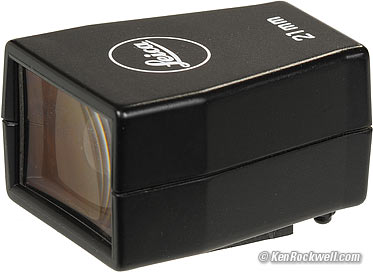 |
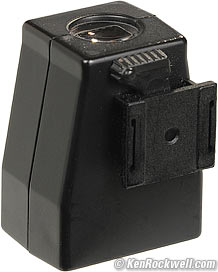 |
Optimum Plastic LEICA 21mm Finder.
The best finder is the plastic LEICA 21mm finder shown here (I think part number 12 012). See See LEICA 21mm Finders for more.
All the finders have a lot of barrel distortion. This affects compsotion, since objects in the sides of the frame will be a lot larger on film than they seem in the finder. This can screw up your composition's balance; another downfall of rangefinder cameras compared to SLRs and view cameras.
If you're only shooting half-frame (M8 or M8.2), you'll only need a 28mm finder since you're throwing away the most expensive half of this 21mm lens' image.
Finder Blockage top
There is only minimal blockage with the standard plastic finder and no hood.

As seen through a LEICA 12 008 21mm finder.
If you add the hood, you'll get a little blockage. It's not annoying, but you can see the top of the hood in the bottom of the finder.
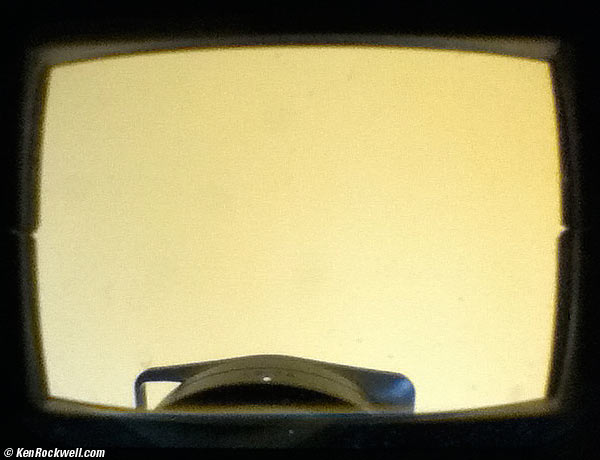
With hood, as seen through a LEICA 12 008 21mm finder.
If you can't see the lens in the bottom of your finder, you're probably using the wrong finder!
You get less blockage with the LEICA Universal Wide Finder because it sits higher in the shoe.
Flare and Ghosts top
Be careful at night with very bright sources of light shining right into the lens: if you really push it, you'll get some ghosts opposite the source of light.
Otherwise, no problem.
Focus top
Focus is fast, smooth and easy. Damping is perfect: not too loose, and certainly never too tight.
The little focus nubbin is excellent: just poke it with your finger and you're there.
The rangefinder system is overkill for this lens. You easily can focus more precisely than you'll ever need.
Of course the LEICA rangefinder couples to this lens, but you can get good focus even by guessing due to the huge depth of field.
LEICA 21 2.8 ASPH. enlarge.
Long Exposures Hand-Held top
I can shoot at 1/6 and get sharp results most of the time on an M7.
This is a huge advantage of the LEICA system and ultrawide lenses.
Mechanics and Construction top
The LEICA 21mm f/2.8 ASPH is still made like they used to.
Filter Threads: Black anodized aluminum.
Identity Ring: Engraved and filled metal inside filter ring.
Serial Number: Engraved and filled on identity ring.
Barrel: Black anodized aluminum.
Focus and Aperture Rings: Black anodized aluminum.
Focus Scale: Engraved in feet and meters. Marked at 28," 3,' 4,' 5,' 6,' 8,' 12,' and 0.7, 0.8, 1, 1.2, 1.5, 2, 3, and 5 meters.
Focus Ring Rotation: 110.º
Focus Helicoids: Aluminum and brass.
Other Internals: Metal.
Mount: Dull chromed brass.
Mounting Index: Red plastic dot.
Markings: Engraved and filled with paint.
Quality: Made in Germany.
Sharpness top
I was slightly disappointed compared to the Zeiss-for-Contax G 21mm f/2.8, which is sharp no matter what you do to it, even in the corners at f/2.8.
This LEICA lens is always sharp in the center, but it's softer in the corners at f/2.8, gets better at f/4, but doesn't get really good until f/5.6. It's always sharp in the center.
You'd never notice this unless you were shooting deliberate tests at infinity wide-open in daylight, but if you do, I prefer the Zeiss-for-Contax G lens. The MTF curves for each lens tend to bear this out.
Other LEICA lenses are so sharp that this one seems relatively lackluster by comparison. It is a very sharp lens, just not as insanely sharp in the corners wide-open as other LEICA lenses, which is to be expected in an ultrawide.
LEICA 21/2.8 ASPH. enlarge.
Comparisons top
Intro Specs Performance Compared Recommendations
See also All LEICA 21mm lenses Compared and my Voigtländer 21mm f/4 Review.
The new 2011 LEICA SUPER-ELMAR-M 21mm f/3.4 ASPH is superior to this lens, and sells for less.
LEICA's 21mm f/1.4 top
LEICA's newest 21mm f/1.4 is silly because it's too big, it weighs twice as much, it doesn't play well with filters (if you buy an adapter, it might take 82mm filters), it has 50% more distortion and is not generally as sharp as this 21mm f/2.8 Aspherical. At f/1.4, the 21mm f/1.4 has three stops of falloff in the corners, meaning that it's really only an f/4 lens in the corners. (source).
I wouldn't pay $6,000 for a lens I'd like less than this far more compact 21mm f/2.8.
Zeiss-for-Contax G and Nikon top
Zeiss-for-Contax G 21mm f/2.8, LEICA 21/2.8 and Nikon 20mm f/2.8 AI-s. enlarge.
Optically, I prefer the Zeiss-for-Contax G 21mm f/2.8. It's slightly sharper wide open and has far less distortion than this LEICA 21mm f/2.8. I can see distortion with this LEICA lens, but I can't see any with the Zeiss-for-Contax G. According to the manufacturers' data, the Zeiss-for-Contax G has only one-third the distortion of this LEICA lens. That's because the Zeiss lens appears not to be a retrofocus design, while this LEICA lens is.
Of course this LEICA lens is far better for any shooting where you need to calculate depth of field. The Contax lens has no focus scale: you only have access to a digital readout on the Contax G1 and G2 bodies. Therefore I have to add a written note to myself for my new-age hyperfocal distances at various apertures on the Contax lens, and if the far point of my subject isn't infinity, I'm lost.
By comparison, the LEICA lens has an ordinary focus scale with which I can do my calculations.
Each takes the same filters.
The Nikon 20mm f/2.8 AI-s is an SLR lens. It is nowhere near as sharp or as distortion free as any of these rangefinder lenses. I included it for scale.
Here are the weights as I measured them:
| Lens (filter size) | Ounces |
Grams |
| LEICA 21mm f/1.4 ASPH (series VIII) | 20.5 oz.* |
580g* |
| LEICA 21mm f/2.8 ASPH (55mm) | 11.195 oz. |
317.4g |
| Zeiss-for-LEICA 21mm f/2.8 (46mm) | 9.9 oz.* |
280g* |
| Nikon 20mm f/2.8 AI-s (62mm) | 9.120 oz. |
258.6g |
7.4 oz.* |
190g* |
|
| Zeiss-for-Contax G 21mm f/2.8 (55mm) | 6.280 oz. |
178.1g |
| Cosina (Voigtländer) 21mm f/4 (39mm) | 4.79 oz.* |
136g* |
* As specified, not measured.
Amazing but true, this LEICA lens is by far the heaviest, and the Zeiss-for-Contax is the lightest I've tried, which is more in favor of shooting the Zeiss-for-Contax G lens on the Contax instead of the LEICA.
If distortion bugs you, try the made-in-Japan Zeiss 21mm f/4.5 in LEICA mount, which has no distortion and costs much less than this LEICA lens.
I need to get my hands on the Cosina 21mm f/4 for LEICA M and see what happens. It's the smallest 21mm lens there is.
More Information: top
LEICA's Technical data for the 21mm f/2.8 ASPH
LEICA's Technical data for the 21mm f/1.4 ASPH
Zeiss' technical data for 21mm f/2.8 Contax G
Zeiss' technical data for the 21mm f/4.5 in LEICA mount
Zeiss' technical data for their 21mm f/2.8 in LEICA mount
(Oriental brands, Nikon, Cosina (Voigtländer), lack the confidence to share this data.)
Recommendations top
Intro Specs Performance Compared Recommendations
For shooting on LEICA M, the reason to shoot this lens is because it feels right. See that complex multi-part mechanical hood? It's like something straight out of Hollywood, not the lame plastic contrivances of lesser consumer lenses. If you're going to spend the money on a LEICA, you may as well get the right lenses for it.
It might seem silly to an outsider, but I love this lens not just because of the great optics, but also largely because it feels so good in-hand. That silly little focus knob lets me shoot faster and easier than I can with the crummy AF system of the Contax G.
I prefer the optical performance of the incredible Japanese Zeiss-for-Contax G 21mm f/2.8, but of course you need to shoot it on a Contax G body unless you go crazy and adapt one for LEICA. If you just want optical quality at a low price along with great ergonomics, the Contax G is mostly a better system.
The Cosina Voigtlander 21mm f/4 is tiny, but won't work well with the sensors of the LEICA M9 and LEICA M9-P.
The Zeiss-for-LEICA 21mm f/4.5 and ZEISS 21mm f/2.8 are also good lenses.
If you've found all the effort I put into sharing this research helpful, this free website's biggest source of support is when you use these links, especially this link directly to them at eBay, where they sell for about $4,000 (see How to Win at eBay). It helps me keep reviewing these oldies when you get yours through these links, thanks! Ken.
Deployment
I use the hood and its slide-over cap.
I'd use a 55mm 81A B+W brand filter for slide film.
I'd use any 55mm B+W brand yellow filter for B&W film outdoors, or a 55mm LEICA brand 13 373 UV filter indoors.
I'd use a 55mm LEICA brand 13 373 UV filter for color print film, but why would anyone shoot color print film in a LEICA?
I wouldn't bother with a digital LEICA until they come out with a full-frame body, and even then film is more fun, but that's just me. I'm told digital shooters today need to use a LEICA brand 55mm UV/IR filter 13 413 (or a B+W brand 55mm UV/IR filter) to correct for a design flaw in the M8.2's sensor system design.
Help me help you top
I support my growing family through this website, as crazy as it might seem.
The biggest help is when you use any of these links to Adorama, Amazon, eBay, Ritz, Calumet, J&R and ScanCafe when you get anything, regardless of the country in which you live. It costs you nothing, and is this site's, and thus my family's, biggest source of support. These places have the best prices and service, which is why I've used them since before this website existed. I recommend them all personally.
If you find this page as helpful as a book you might have had to buy or a workshop you may have had to take, feel free to help me continue helping everyone.
If you've gotten your gear through one of my links or helped otherwise, you're family. It's great people like you who allow me to keep adding to this site full-time. Thanks!
If you haven't helped yet, please do, and consider helping me with a gift of $5.00.
As this page is copyrighted and formally registered, it is unlawful to make copies, especially in the form of printouts for personal use. If you wish to make a printout for personal use, you are granted one-time permission only if you PayPal me $5.00 per printout or part thereof. Thank you!
Thanks for reading!
Mr. & Mrs. Ken Rockwell, Ryan and Katie.
Home Donate New Search Gallery Reviews How-To Books Links Workshops About Contact


